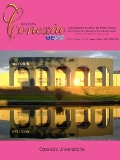RIO NEGRO-RS WATERSHED: THE IMPORTANCE OF KNOWLEDGE FOR MANAGEMENT - DOI: 10.5212/Rev.Conexao.v.12.i3.0010
DOI:
https://doi.org/10.5212/Rev.Conexao.v.12.i3.0010Keywords:
Rio Negro River- RS, Watershed, Environment, Outreach University Project.Abstract
This paper presents the University Outreach Project “Negro River watershed: the importance of knowledge for management”, its main aspects and the results achieved so far. The project has been developed since the end of 2012, and aims to promote actions that result in greater knowledge about the physical, social and environmental aspects about the Negro River watershed. The method used for the development of the project include: a) the study of the problem; b) the definition of the outreach actions; c) planning the actions; d) implementing the actions; and f) evaluating the actions taken. After three years of the project, it is possible to say that it has been contributing to raise the awareness of the population that lives in the Negro River Watershed about its importance for the local and international context, as well as about the preservation of water resources located within the watershed.
Downloads
References
ANA – AGÊNCIA NACIONAL DE ÁGUAS. Conjuntura dos recursos hídricos no Brasil: Informe 2014. Brasília, 2015.
ANA – AGÊNCIA NACIONAL DE ÁGUAS. Arquivos digitais do Sistema de Informações Hidrológicas HidroWeb. Disponível em: http://hidroweb.ana.gov.br/HidroWeb.asp?TocItem=4100. Acesso em 05/03/2015.
BRASIL. Lei nº 9.433, de 8 de janeiro de 1997. Brasília, 1997.
DAEB - DEPARTAMENTO DE ÁGUA E ESGOTO DE BAGÉ– Caracterização e diagnóstico da bacia do Rio Negro em Território Brasileiro-RS. Contrato n0 004/2007. Bagé, 2007.
GOOGLE. Google Earth Pro. Version 7.1.5.1557. 2016. Área de abrangência da bacia hidrográfica do Rio Negro-RS. Disponível em: https://www.google.com.br/earth/download/ge/agree.html. Acesso em: 15/07/2015.
Hasenack, H.; Weber, E.(org.) Base cartográfica vetorial contínua do Rio Grande do Sul - escala 1:50.000. Porto Alegre: UFRGS Centro de Ecologia. 2010. 1 DVD-ROM. (Série Geoprocessamento n.3). ISBN 978-85-63483-00-5 (livreto) e ISBN 978-85-63843-01-2 (DVD).
IBGE. Censo Demográfico 2010 - Resultados do universo. Disponível em: http://www.ibge.gov.br. Acesso em: 20 out. 2013.
IHP-HWRP.GLOWA: Global change and the hydrological cycle. Germany Federal Ministry of Education and Research.Koblenz, 2008.
MENDOZA, M., LÓPES-GRANADOS, E., GENELETTI, D. PÉREZ-SALICRUP, D., SALINAS, V.Analysing land cover and land use change processes at watershed level: A multitemporal study in the Lake Cuitzeo Watershed, Mexico (1975-2003). Applied Geography, 31, 237-250, 2011.
MUNROE D., MÜLLER D. Issues in spatially explicit statistical land-use/cover change (LUCC) models: Examples from western Honduras and the Central Highlands of Vietnam. Land Use Policy, 24, 521–530, 2007.
RAVANELLO, M. M.; PANTE, A. R. Outorga de direito de uso de recursos hídricos em bacia carente de dados – Rio Negro-RS. Anais do XX Simpósio Brasileiro de Recursos Hídricos. Bento Gonçalves, 2013.
RIO GRANDE DO SUL. Decreto n° 45.531, de 5 de março de 2008. Porto Alegre, 2008.
SAJIKUMAR,N., REMYA, R. Impact of land cover and land use change on runoff characteristics. Journalof Environmental Management, 161, 460-468, 2015.
SEMA- SECRETARIA ESTADUAL DE MEIO AMBIENTE. Relatório Anual sobre a Situação dos Recursos Hídricos no Estado do Rio Grande do Sul. Porto Alegre: SEMA, 2006.
SEMA- SECRETARIA ESTADUAL DE MEIO AMBIENTE. Relatório Anual sobre a Situação dos Recursos Hídricos no Estado do Rio Grande do Sul. Porto Alegre: SEMA, 2012.
SEMA- SECRETARIA ESTADUAL DE MEIO AMBIENTE. Limites das bacias hidrográficas do Rio Grande do Sul. Disponível em http://www.sema.rs.gov.br/conteudo.asp?cod_menu=21&cod_conteudo=6463. Acessoem 05/03/2015.
UNESCO.The United Nations World Water Development Report 2003: Water for People Water for Life. UNESCO,França, 2003.
UNESCO.The United Nations World Water Development Report 2015: Water for a Sustainable World. UNESCO,França, 2015.
XIAO, J., SHEN, Y., GE, J., TATEISHI, R., TANG, C., LIANG, Y. et al.. Evaluating urban expansion and land use change in Shijiazhuang, China, by using GIS and remote sensing. LandscapeandUrban Planning, 75 (1/2), 69-80, 2006.
Downloads
Additional Files
Published
Issue
Section
License
a) Authors retain copyright and grant the journal right of first publication with the work simultaneously licensed under a Creative Commons Attribution License that allows others to share the work with an acknowledgement of the work's authorship and initial publication in this journal.
b) By submitting an article to the Revista Conexão UEPG and having it approved, the authors agree to assign, without compensation, the following rights to the Journal: the rights of first publication and the rights to redistribute the article and its metadata to the indexing and reference services that the editors deem appropriate.
c) Readers are free to transfer, print out and use the articles published in the Journal, as long as there is always explicit mention to the author(s) and to the Revista Conexão UEPG and as long as there is no alteration of the original work. Any other use of the texts needs to be approved by the author(s) and by the Journal.






